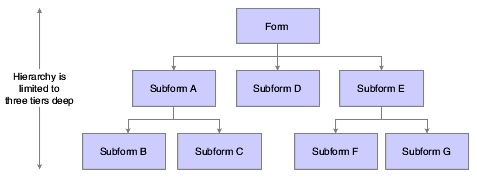Power Browse Form Hierarchical Structures
Hierarchical relationships govern the processing between containers in the application. The power form enables you to create hierarchies based on BVs using power forms and subform controls. A power form always resides at the top of the hierarchy. It is a parent form, and can have multiple subform children. Subforms also can function as parent forms, and they can have multiple children. All subforms must have at least one parent power form or subform. At most, you can have three levels, including the initial power form, in a power form hierarchy.
This flowchart illustrates the general hierarchy scheme of power forms:

Object |
Passes Logic To and From |
|---|---|
Power Form |
Subforms A, D, and E |
Subform A |
Power Form, Subforms B and C |
Subforms B and C |
Subform A, Power Form |
Subform D |
Power Form |
Subform E |
Power Form, Subforms F and G |
Subforms F and G |
Subform E, Power Form |